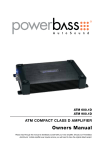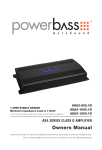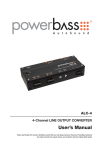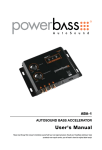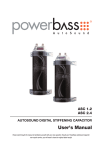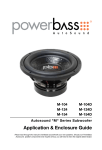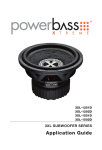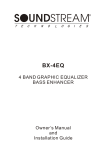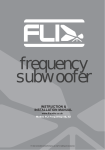Download Owners Manual
Transcript
XAX 500D XTREME SERIES MINI AMPLIFIER Owners Manual Please read through this manual to familiarize yourself with your new amplifier. Should your PowerBass Xtreme mobile amplifier ever require service, you will need to have the original dated receipt. AMPLIFIERS Thank you and Congratulations Thank you for your decision to purchase a PowerBass USA Xtreme mobile amplifier! Our new mini amplifiers are the result of extensive engineering, testing, and bullet proof construction. Their versatility enables compatibility with optional signal and audio processors. These high quality MOSFET amplifiers may be configured to allow maximum flexibility in designing different types of speaker systems. D CLASS MINI AMPLIFIERS The PowerBass XAX Series are high quality MOSFET amplifiers that are capable of running a system full range, or they may be selected only to power subwoofers. It is important that you closely follow the wiring instructions contained in this Owners Manual so that you get the most from your PowerBass Xtreme mobile amplifier. ∆ Caution ∆ High powered audio systems in a vehicle are capable of generating higher then “Live Concert” levels of sound pressure. Continued exposure to excessively high volume sound levels could cause hearing loss or damage. Also, operation of a motor vehicle while listening to audio equipment at high volume levels may impair your ability to hear external sounds such as horns, warning signals, or emergency vehicles—thus creating a potential traffic hazard. In the interest of safety, PowerBass USA highly recommends listening at lower volume levels when driving. 3 TECHNICAL FEATURES • Class D Mono Amplifier • Philips/NXP Chip Set • Ultra Low Current Draw • High Damping Control Circuit • High Efficiency SMD Circuit Technology • Double Sided Copper Plated PCB • Digital Sound Optimization Circuitry • Dead Zero Switching • High Current Voltage Ripple Rejection Circuitry • Virtual Silence Turn On/Off Mute Circuit • Temperature Controlled Output Current Limiting Protection • Subsonic Filter (variable 10Hz-50Hz) • Dual Link Power Doubling Circuitry • Platinum Tiffany RCA Connectors • Wired Remote Gain Control INSTALLATION EXPERIENCE Installation of PowerBass mobile amplifiers requires detailed knowledge of electronics wiring and proper speaker impedance. We strongly recommend installation by an authorized PowerBass dealer. This Owners Manual only provides general installation and operation instructions. If you have any reservations about your installation skills, please contact your local PowerBass dealer for assistance. IMPORTANT : This amplifier is designed for operation in vehicles with 12-volt Negative ground electrical systems only. PREPARING FOR INSTALLATION NOTE: The tools listed below may be required for basic installation • An electric drill with bits • Philips head and standard screwdrivers • Wire strippers • Crimping tool • VOM (electronic volt ohm meter) • Heat shrink tubing and heat gun • Soldering iron • Electronic (not Acid Core) Solder INSTALLATION PRECAUTIONS NOTE: Proceed only if you are a qualified installer, otherwise; see your Authorized PowerBass Dealer to professionally install this amplifier. Always wear protective eyewear when using tools. • • • • • • • • Turn off all stereo and other electrical devices before you begin. Disconnect the negative (-) lead from your vehicles battery. Locate all fuel lines, brake lines, oil lines, and electrical cables when planning the install. Make sure there is at least 2-inches (5 cm) around the air vents on the amplifier. When connecting ground points, make sure all paint is carefully scrapped away from the auto body and contact is make with bare metal. Use a utility knife to trim away fabric from hole locations before drilling or cutting. When running power cables through sheet metal, be sure to use grommets to properly insulate the metal edges from the wire insulation. If possible, use tubing through grommets. MOUNTING THE AMPLIFIER Fig.1 Mounting the Amplifier Due to the high power output of the PowerBass Xtreme Class D amplifiers, considerable heat may be produced when the unit is in operation. For this reason the amplifier should be mounted in a location which will allow air to circulate freely. A clearance of at least 2-inches (5 cm) to all sides of the amplifier is necessary not only for proper cooling, but also for gaining access to the inputs and other variable controls. Be sure that the power and signal cable connections can enter and leave the amplifier in a straight line to avoid the risk of kinked wires causing malfunction. 5 MOUNTING LOCATION Find a clear and well ventilated area to mount your amplifier that is unobstructed by any objects that will cause harm or block ventilation. You may use the amplifier as a template and mark the four screw locations with a felt tip pen. Use caution to make sure there are no objects behind the installation surface that may become damaged during drilling. The amplifier should be protected from exposure to moisture and direct sunlight. The compact size of the PowerBass XAX series amplifier allows greater flexibility in mounting. The best places to mount your amplifier are: The floor of the trunk, under the driver’s seat, or on the back of the rear seat. For alternate installation locations, please consult your authorized PowerBass Dealer. • • • • • *** WARNING *** Upside down mounting will compromise heat dissipation through the heatsink and could engage the thermal protection circuit. Try to avoid mounting the amplifier on a subwoofer enclosure, as extended exposure to vibration may cause malfunction of the amplifier. Don’t mount the amplifier so that the wire connections are unprotected or are subject to pinching or damage from nearby objects. The DC power wire must be fused at the battery positive (+) terminal connection. Before making or breaking power connections at the amplifier power terminals, disconnect the DC power wire at the battery end. The battery of the car audio system must be disconnected until the entire wiring and installation is completed. CONTROL PANEL LAYOUT Fig.2 Panel Layout NOTE: Panel Layout and Controls may differ by model. 1. Line INPUT (RCA) Jacks These RCA style input jacks are for use with source units that have RCA line level outputs. A source unit with a minimum output of 500mV is required for proper operation. However, this input will accept levels up to 6Vrms. 2. GAIN Control This control is used to match the input sensitivity of the amplifier to the particular source unit that you are using up to 6 volts. 3. SUB SONIC Control This control is continuously adjustable from 10Hz - 50Hz at 12dB per octave to provide an extra level of speaker protection from bass robbing power at unheard frequencies. 7 4. PHASE Switch This switchable control can be used to correct any “phase” or “time delay” effect in the system by bringing the low frequency from the rear of the vehicle to the front. 5. BRIDGED CONNECTION Port For linking two of the same model PowerBass Autosound Class D amps together. Connect the INPUT of the MASTER to a suitable source via a standard telephone wire with RJ45 modular connectors to the jack on the SLAVE amplifier. Then select the MASTER/SLAVE switch properly (see Speaker Output Configuration diagram). 6. BASS FREQ Control This control is variable from 40Hz to 100Hz and allows you to choose the exact frequency you want to boost using the BASS EQ feature. 7. BASS EQ Control This equalization circuit is used to enhance the low frequency response of the vehicle’s interior. With up to 18dB of boost centered at 45Hz, the BASS EQ can be adjusted to meet your own personal taste. 8. SLAVE / MASTER Switch Two like amplifiers can be connected together and bridged into a single 2-ohm (min) load. The level and frequency controls on the SLAVE amp will be disabled. Only the amplifier you select as the MASTER will control these functions. The Dual Link Power Doubling Circuit increases the output power as follows: XAX 500D x 2 = 1,000 watts RMS (2 ohms min) NOTE: If using only one amplifier this switch should remain in the MASTER position. 9. LPF (Low Pass Filter) Control This filter allows low pass of frequency and is adjustable from 25Hz through 250Hz to eliminate unwanted high frequencies. 10. REMOTE Gain (RJ45 Jack) This is the connector port for the Remote Gain Control. Now the amplifiers secondary gain circuit can be adjusted from the driver’s seat. 11. POWER Indicator The clear L.E.D. lights BLUE when the power is on. 12. STATUS Indicator This L.E.D. glows RED when the built-in protection circuitry is activated. This indicates a problem with the system in relation to the amplifier (see Troubleshooting Tips). 13. SPEAKER Output Terminals As shown in the wiring diagrams, be sure to observe speaker polarity through the system and speaker impedance. This specially tooled terminal is designed to accommodate up to 10 gauge speaker wire. 14. FUSES For convenience all PowerBass Xtreme mini amplifiers utilize common automotive ATC type fuses. For continued protection in the event that a fuse blows, replace the fuse only with the same value. CAUTION: These power fuses on the amplifier chassis are for protecting the amp against overdrive. To protect the vehicles electrical system, an additional fuse should be used within 18-inches of the battery on the 12V+ cable. XAX 500D 25A x 2 15. BATT+ (Power Input Connection) This solderless terminal is the main power input for the amplifier and must be connected directly to the positive (+) terminal of the car battery. This terminal accepts up to 2 gauge wire. (see Power Cable Selection Chart for recommended wire gauge for each model). 16. REMOTE (Remote Input Connection) All PowerBass Xtreme amplifiers can be turned on by applying 12 volts to this terminal. This can be found on the rear of the source unit in the form of an electric antenna output, or a remote output. If this is not available you can wire to the ACC position on the key. An 18 gauge wire is sufficient to run the REMOTE. 17. GND (Ground Input Connection) A good quality ground is required for your PowerBass Xtreme D Class amplifier to operate at peak performance. A short length of cable the same gauge as your power cable should be used to attach the ground terminal directly to the chassis of the vehicle. Make sure that all of the paint is sanded or scraped away to ensure a quality ground connection. 9 POWER WIRING AND SIGNAL CONNECTIONS *** WARNING *** Disconnect the negative (-) battery terminal before you start any wiring work! The battery of your car audio system must be disconnected until the entire wiring installation is completed. Your PowerBass Autosound Class D amp will draw large levels of current, so use the largest gauge power/ ground cable as possible. Using too small of power cable can result in unnecessary over-heating of the amplifier, distortion at high volume levels and might even cause the thermal protection circuitry to shut-off the amplifier. Remember, bigger wire is better! • Use rubber grommets when running cables through any metal or sharp plastic, to prevent accidental shorting or shearing. Make sure the cables do not interfere with normal operation of the vehicle. • The audio signal cables (RCA interconnects) should be kept far away from any potential sources of electrical interference such as electronic vehicle management systems (relays, engine computers wiring harnesses, fuel pumps etc.) SPEAKER BATT+ REMOTE GND FUSE SUBWOOFER OUTPUT 25A 25A FUSE HOLDER Battery Within 18" of Battery Chassis Ground (–) Remote Turn ON To Power Antenna Fig.3 Power Input Connection This amplifier is designed to work within a 10 to 16 volt DC range. Before any wires are connected, the vehicles electrical system should be checked for correct voltage supply with the help of a voltmeter. First, check the voltage at the battery with the ignition in the OFF position. The voltmeter should read no less than 12V. If your vehicles electrical system is not up to these specifications, we recommend having it checked by an auto electrician before any further installation. Once the vehicle is checked, make certain the correct cable gauge is used. We recommend using as large a gauge cable as possible, use the Power Cable Selection Chart to calculate the correct power wire size for your application. POWER WIRING BATT+ (Power) This amplifier should be wired directly to the vehicle battery using the appropriate size cable. Start at the vehicle battery and run the power cable through to the amplifier. Avoid running the power cable over engine components and near heater cores. The use of an inline fuse or circuit breaker is a must; this will prevent the risk of a potential fire caused by a short in your power cable. Connect the fuse holder or circuit breaker as close to the battery positive (+) terminal as possible (no farther then 18” from that battery). This fuse or circuit breaker should be no greater then the sum of the fuses found on the chassis of your amplifier (also see specifications chart). You may now connect the cable to the battery, but remember to leave the fuse out or circuit breaker “off” until all other cable connections are made. GND (Ground) When grounding your amplifier, locate a metal area close to the amplifier that is good source of ground (preferable the floor pan). Once again, investigate the area you wish to use for electrical wires, vacuum lines, and brake or fuel lines. Use either a wire brush or sandpaper to eliminate unwanted paint for better contact of the ground. Secure the ground cable to the body using a bolt, star washer and nut. Spread silicon over the screw and bare metal to prevent rust and possible water leaks. Factory Bolt Ring Connector Ground Wire Star Washer Note: Remove any paint below ring connector Now it’s time to connect the power and ground cables to the amplifier. Cut both cables to length. Strip off 1/2 inch (12mm) of the insulation so that the bare wire fits all the way in the terminal block on the side panel of the amplifier, seating it firmly so no bare wire is exposed. Use a Philips screwdriver to loosen the BATT+ and the GND connections on the amplifier. Insert the ground first, and then the +12V and please make sure that you place them into the correctly marked terminals. Then tighten the screws down securely. 11 REMOTE (Remote Trigger) This terminal must be connected to a switched +12V source. Typically, remote turn-on leads are provided at the source unit that will turn on and off the amplifier in correspondence with the source. If the source unit does not have a remote turn-on lead, then a power antenna wire can be used. If neither of these leads is available at the source unit, then a switched +12V supply must be used, like the ACC, +12V. Run a minimum of 18 gauge wire from the amplifier location to the source of the switched +12V lead. If possible, route this wire on the same side of the vehicle as your power cable. Connect the source remote output to the wire. Go back to the amplifier and cut the wire to length. Loosen the screw terminal marked REMOTE on the amplifier. Insert the stripped (bare) portion of the wire into the terminal and tighten the screw securely. RCA INTERCONNECT WIRING Fig.4 Low Level Input using RCA Choose the correct length and style of RCA interconnects for your needs. Always use high quality RCA audio cables (not supplied) for signal connections—those with multiple layers of shielding or a twisted pair variety for better noise rejection. Be extra careful when routing your RCA audio interconnect cables. Car environments are notorious for poorly insulated wires. This means that hiss, engine noise, and fan noise can easily be picked up through RCA cables if run incorrectly. Make sure that the cables for power and audio signal are not on the same side of the vehicle and that they do no cross each other; this will help reduce any noise that may radiate from the power cable and the signal cable. If an audio cable is too close to a power cable, it may pick up the magnetic field generated by the power cable, which could lead to a loss of quality in your signal. 13 SET UP ADJUSTMENTS Input GAIN Adjustment GAIN MIN MAX Input Sensitivity Control Fig.5 GAIN Control This control allows you to match the input level of the amplifier to the output level of your head unit. Matching the input can be accomplished in four simple steps: 1. Make sure that the remote gain control is not plugged in until after the master gain control is set. 2. Set the GAIN control on the amplifier to Min (completely counter clock wise). 3. Turn on the head unit and adjust volume to 2/3 maximum, and set the BASS and TREBLE to zero. 4. Adjust the LEVEL control clockwise until the sound just begins to distort, then back off slightly to cut distortion and operate at optimum gain. Remember, the GAIN control is not a volume control. Ignoring these steps above may leave you with damaged speaker and/or a damaged amplifierr. 10Hz SUB SONIC Adjustment 50Hz Fig.6 Sub Sonic Adjustment The sub sonic control will filter out all frequencies below where the control it is set from going to your subwoofer(s). This will prevent your subs from playing any low frequencies that may harm the speaker 25Hz 250Hz Fig.7 Low Pass Control LPF (Low Pass Filter) Adjustment The crossover frequency adjustment filters out frequencies that you don’t want your speaker(s) to reproduce. Using the LPF control, adjust the Low Pass Frequency to limit the amount of mid range you want going to your woofer(s). Since musical tastes vary, adjust the crossover by ear while listening to the music of your choice. Be sure to set the tone controls of your source unit to flat before adjusting the crossover 0dB 40Hz +18dB Fig.8a Bass EQ Control 100Hz Fig.8b Bass FREQ Control Adjusting the BASS EQ and BASS FREQ Controls The BASS EQ is adjustable from 0-18dB, thus allowing you to tailor your sound system to your particular tastes. The BASS FREQ lets you choose the frequency that the BASS EQ will boost. You will want to experiment with both controls—begin your adjustments at low volume. First turn the BASS EQ control about half-way up. Next, vary the BASS FREQ control up and down. Adjust both controls until you find the right combination that sounds best with the music you listen to most. NOTE: More is not always better. By turning the BASS EQ all the way up to 18dB you can overwork the amplifier and send the unit into thermal protection. Fig.9 Connection with RJ45 Jack Remote Gain Controller Connection Your PowerBass Xtreme Class D amp includes a Remote Gain control module. It uses standard telephone wire and telephone RJ45 connectors. To connect the Remote Gain Control to the amplifier, simply insert one end of the telephone plug into the REMOTE Gain port. Plug the other end into the remote module. Install the module within easy reach on or under your dash. 15 SPEAKER WIRING AND CONFIGURATIONS Speaker Load Keep in mind your PowerBass Autosound Class D amp is a high power amplifier and not a high current amplifier. In other words it requires a minimum impedance of 1 ohm. If you are unsure of calculating impedance loads please consult your Authorized PowerBass Autosound Dealer before damaging your amplifier. Too low of an impedance could send your amplifier into protection mode and/or damage the amplifier Speaker Wiring Choose the correct speaker wire for your application. We recommend a minimum of 16 gauge wire. Route these using the same precautions as you did when you ran the power cable. Terminate these wires at the speaker end using insulated speaker terminals (not supplied) or by soldering the connection to the speaker. Be certain to maintain correct polarity throughout the system. Make sure the speaker connections are positiveto-positive and negative-to-negative. Most speaker wire has some indicator (color code, ribbing, or printing) on one of the two wires to help you distinguish the positive (+) and negative (-) leads. At the amplifier end, insert the stripped (bare) speaker wires into the properly marked terminals. Use a Phillips screw driver to loosen the speaker terminals on the amplifier. Make certain that no bare wire ends touch each other. Such contact could result in an electrical short and cause the amplifier to turn off (short circuit protection) or malfunction. NOTE: It is highly recommended that a hand screw driver and NOT a power drill is used to tighten the set screws on the terminal blocks. This will prevent stripping or other possible damage to the amplifier. Speaker Output Configurations 1. A SINGLE VOICE COIL SUBWOOFER SPEAKER Fig.10 A Single Voice Coil Subwoofer (1~4 ohm) 2. TWO SINGLE VOICE COIL SUBWOOFER SPEAKERS (Note: Don’t connect speaker impedance under 1 ohm) Fig.11 Two 4 ohm Subwoofers with Single Voice Coil 17 3. ONE DUAL VOICE COIL SUBWOOFER SPEAKER (Note: Don’t connect speaker impedance under 1 ohm) SPEAKER BATT+ REMOTEG ND FUSE SUBWOOFER OUTPUT 25A 25A Fig.12 One Subwoofer (2~4 ohms) with Dual Voice Coil 2-4 ohms DUAL VOICE COIL SUBWOOFER Dual 4 ohm becomes 2 ohm as shown above Dual 2 ohm becomes 1 ohm as shown above CAUTION: Maintaining proper impedance is critical when wiring the Class D model amplifiers. Improper wiring can cause severe damage to BOTH the woofer and the amplifier. Detailed wiring diagrams are supplied with all PowerBass woofers. IF YOU ARE NOT EXPERIENCED OR UNCOMFORTABLE READING THE WIRING DIAGRAMS CONSULT YOUR AUTHORIZED POWERBASS DEALER BEFORE YOU ATTEMPT TO WIRE THE SYSTEM. 4. DUAL LINK AMP TO AMP BRIDGED CONNECTION Bridging two amplifiers ( of same model) can be done via the SLAVE/MASTER switch, BRIDGED CONNECTION cable and speaker wiring the two amplifiers as follows: Fig.13 Dual Link minimum 2 ohm load NOTE: SPEAKER CONNECTION FOR BRIDGING TWO AMPS • The mono woofer must be connected between the speaker (+) terminals of the two amplifiers and use at least #12 gauge speaker wiring. • Install a #12 gauge wire link between the speaker (–) terminals of the two amplifiers. If this is not done, the system will not function properly, and damage to the amplifiers may result. • Total impedance of speakers must be over 2-ohms. If the impedance drops under 2-ohms, critical damage to the amplifier will occur. 19 RECOMMENDED WIRE SIZES Power Cable Selection Chart Fuse Total 4Ft 4-7Ft 7-10Ft In Amperes 10-13Ft 13-16 Ft 16-19 Ft 19-22 Ft Length of Wire/Gauge 150A - 200A 2 GA 2 GA 2 GA *1/0* *1/0* *1/0* *1/0* 125A - 150A 4 GA 4 GA 4 GA 4 GA 2 GA 2 GA 2 GA 105A - 125A 8 GA 8 GA 8 GA 4 GA 4 GA 4 GA 2 GA 85A - 105A 8 GA 8 GA 8 GA 4 GA 4 GA 4 GA 4 GA 65A - 85A 10 GA 8 GA 8 GA 8 GA 4 GA 4 GA 4 GA 50A - 65A 10 GA 10 GA 8 GA 8 GA 8 GA 8 GA 8 GA PowerBass makes several types of amplifier wiring kits to assist with your installation. Consult your local PowerBass dealer for details. For more information about recommended power wire check out our website at www.powerbassusa.com. PERSONAL NOTES: Name: ______________________________________________________________ Date Purchased: ______________________________________________________ Dealer: _____________________________________________________________ Installed By: _________________________________________________________ Model: _____________________________________________________________ Serial Number: ______________________________________________________ Miscellaneous: ______________________________________________________ This manual is the exclusive property of PowerBass USA, Inc. Any reproduction of this manual, or use other than its intentions is strictly prohibited without the express consent of PowerBass USA, Inc. © Copyright 2010 PowerBass USA, Inc. TROUBLESHOOTING TIPS Problem Solution Power LED not ON With a Volt Ohm Meter (VOM) check: • +12 Volt power terminal (should read +12 to +16VDC • Remote turn-on terminal (should read +12 to +16VDC) • Ground Terminal Power LED lights GREEN, no output • • • • Check RCA connections Test speaker outputs with known good speaker Substitute known good Source Unit Check for signal on the RCA cable with VOM in AC position Red Status Protection LED is ON, no output and 1. Amp is VERY HOT • 2. Amp shuts down ONLY when the vehicle is running • 3. Amp plays at very low volume • Thermal protection is engaged. Check for proper impedance at speaker terminals. Also check for adequate air flow around the amplifier. Voltage protection engaged. Voltage to the amp is not within the 10-16.5 VDC operating range. Have the battery/charging system inspected. Short circuit protection is engaged.Check for speaker wires shorted to each other or the vehicle chassis. Speakers operating below the minimum impedance an cause this to occur. Alternator noise (varies with RPM) • • • • Poor Bass Response Check speaker polarity, reverse the connection of one speaker only. Check for damaged RCA cable. Check routing of RCA cable Check Source Unit for good ground Check amp gain setting, turn down if set too high NOTE: If the Status L.E.D. is activated and glows RED with no speakers connected to the amplifier, and all the power connections are correct, this would indicate an internal problem with the amplifier. Contact PowerBass USA or your local dealer. 21 SPECIFICATIONS FOR XAX 500D AMPLIFIER PowerBass Xtreme Class D Model XAX 500D Power Output @ 14.4 VDC Input • 1 Ohms RMS at THD <1% 500 x 1 • 2 Ohms RMS at THD <1% 400 x 1 • 4 Ohms RMS at THD <1% 250 x 1 1 Ohms Max OUTPUT 1000 watts • Signal to Noise Ratio > 80dB Frequency Response 10Hz - 250Hz Crossover • Low Pass Filter 25Hz - 250Hz • Crossover Slope 12dB • Sub Sonic Filter 10Hz - 50Hz • Bass EQ at 45Hz Input Gain Control 0.5 - 6.0 V Low Level Input Impedance 200 mV Damping Factor > 200 Fuse Rating/ ATC Style 25A x 2 Dimension • Width (W) x 7.08" (180mm) • Height (H) x 1.92" (49mm) Length (L) mm 10.26" (260.6mm) • Important Notes: • Due to continuing improvements these specifications are subject to change without any notice. • Do not attempt to fix or repair this unit. Unauthorized repairs will void the manufacturer’s warranty. POWERBASS ELECTRONICS LIMITED WARRANTY POLICY PowerBass USA, Inc. offers limited warranty on PowerBass products under normal use on the following terms: PowerBass Xtreme Amplifiers are to be free of defects in material and workmanship for a period of one (1) year. This warranty applies only to PowerBass products sold to consumers by Authorized PowerBass Dealers in the United States of America. Products purchased by consumers from a PowerBass dealer in another country are covered only by that country’s Distributor and not by PowerBass USA. This warranty covers only the original purchaser of PowerBass product. In order to receive service, the purchaser must provide PowerBass with the receipt stating the consumer name, dealer, product and date of purchase. Products found to be defective during the warranty period will be repaired or replaced (with a product deemed to be equivalent) at PowerBass’s discretion and will not be liable for incidental or consequential damages. PowerBass will not warranty this product under the following situations: • Amplifiers received with apparent rust or corrosion • Any evidence of liquid damage or exposure to excessive heat • Attempted repairs or alterations of any nature • Product that has not been installed according to this owners manual Any implied warranties including warranties of fitness for use and merchantability are limited in duration to the period of the express warranty set forth above. Some states do not allow limitations on the length of an implied warranty, so this limitation may not apply. No person is authorized to assume for PowerBass any other liability in connection with the sale of this product. Please call (909) 993-5399 for PowerBass Customer Service. You must obtain an RA# (Return Authorization Number) to return any product to PowerBass. The RA number must be prominently marked on the outside of the shipping carton or the delivery will be refused. Please pack your return carefully; we are not responsible for items damaged in shipping. Return the defective product along with a copy of the original dated retail sales receipt, plus $12.00 for handling and diagnostic evaluation to: PowerBass USA, Inc., Attn: Returns (RA#__________) 13936 Mountain Avenue, Chino, CA 91710 Residents of HI, AK and US territories will be charged for return shipping. All inquires regarding service and warranty should be sent to the above address. Removed or altered serial numbers will void this warranty 23 PowerBass Xtreme – A division of PowerBass USA, Inc. 13936 Mountain Avenue – Chino, CA 91710 Tel. (909) 993-5399 – Fax (909) 993-5393 www.powerbassusa.com
























